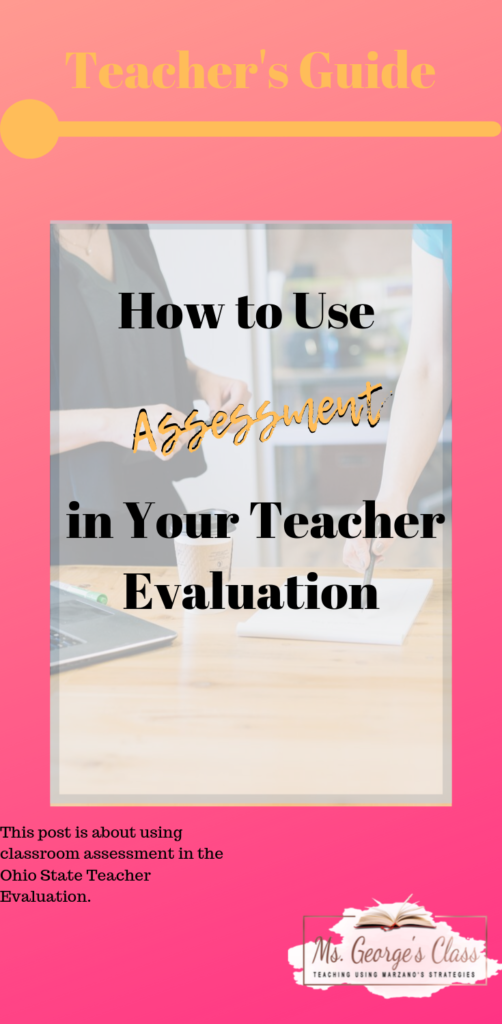This is a 7-part series. You are reading Standard 3 of the 7-part series.

What teacher would not want to be honored for their dedication to their career? Even with a few years under your belt, you still want to be recognized for all your achievements. Early in your career, you could volunteer for every open position and stay after school to assist with programs. In the middle of your career, you get married and have children and your time after school is limited. Towards the end of your career, your children are heading off to college and you’re becoming an empty nester with more time on your hands. In all stages of teaching, you want to be recognized. So you attend professional developments, purchase online courses, register at a local college to take the latest educational course or earn the newest certificate. You read about using assessments, you understand formative and summative assessments, and you learn how to read data from standardize tests. You work hard to remain current in the teaching field and it shows, but your evaluation is not reflecting your hard work. What is wrong? What rubric is your administrator using, and how can you get your hands on it?
Where to Start with the Ohio Teacher Evaluation
In the state of Ohio, educators are evaluated on several teaching criteria. The evaluation rubric has seven areas to evaluate a teacher’s performance or standards. This article will cover one of the areas in a systematic, analytical manner to help teachers improve their scores on the evaluation. The seven areas of evaluation are Standard 1 students, Standard 2 content, Standard 3 assessment, Standard 4 instruction, Standard 5 learning environment, Standard 6 collaboration and communication, and Standard 7 professional responsibility and growth. You may find more information about each standard in the book Standards for Ohio Educators. This a great source to understand each standard and conquer your goal for earning an accomplished teacher score. Since the information is so intensive, purchasing a binder to keep all your documentation is strongly suggested. You can also click here to read another post I have about teacher standards.
First, when analyzing teaching standards, having the rubric available will assist you in understanding the performance assessment. You can click on this link to get the Ohio Department of Education Teacher Performance Evaluation Rubric (this is now a Word Document; click on the link at the bottom of the page). Marzano has included a supplement to the teacher evaluation model that is aligned with the Ohio State Standards. Also, the book Standards for Ohio Educators is where I gathered most of my information. The Ohio Department of Education has included this book on their website; click here to view the book. The rubric is organized differently from the standards. They are organized in this manner:
| The Focus of Teaching and Learning | The Conditions for Teaching and Learning | Teaching as a Profession |
| Standard 1: Students | Standard 5: Learning Environment | Standard 6: Collaboration and Communication |
| Standard 2: Content | Standard 7: Professional Responsibility and Growth | |
| Standard 3: Assessment | ||
| Standard 4: Instruction |
Standard 3: Assessment
According to the Standards for Ohio Educators, Standard 3: Assessment states, “Teachers understand and use varied assessments to inform instruction, evaluate, and ensure student learning” (22). Teachers are to use assessment to maximize student learning to bridge the gap from lesson to performance. Using a variety of assessments will guide a teacher’s understanding of a student’s background and ability to plan and evaluate student learning. Teachers use this data to create lessons and choose strategies that improve learning. There are five elements within Standard 3, and they are:
“3.1 Teachers are knowledgeable about assessment types, their purposes and the data they generate.
3.2 Teachers select, develop and use a variety of diagnostic, formative and summative assessments.
3.3 Teachers analyze data to monitor student progress and learning and to plan, differentiate and modify instruction.
3.4 Teachers collaborate and communicate student progress with students, parents, and colleagues.
3.5 Teachers involve learners in self-assessment and goal setting to address gaps between performance and potentials” (22).
Explaining the Standards of Assessment
The goal for earning accomplished is to write details on your pre-conference form and to provide documentation. Your documentation must show you are proficient and understand the meaning of using assessments within your class. In Standard 3.1, you have to show you are “knowledgeable about assessment types” (22). Explain why you use a specific assessment and how it supports student learning. Describe the various types of assessments and their usage and limitations. Be able to explain why you select an assessment and its validity, reliability, and scoring. To earn accomplished, you can serve as the building or district learner establishing assessment programs.
In my district, we use several assessments. We use the MAP assessment, short-cycle assessments, and the Ohio State Test. Within my own classroom, I use formative and summative assessment. My formative assessment includes observations, thumbs up/thumbs down, writing prompts, and quizzes. My summative assessments are my end of unit tests and MAP testing. I can also prepare data from my district’s reading program MindPlay. During the pre-conference meeting, I suggest you have two pieces of assessments and explain how the data assist you in planning a lesson. Last year, I used a high school senior’s OST data to explain how the assigned work strengthened his skills in his weak areas. Use the data to demonstrate your understanding of how you use the assessment to improve learning.
Standard 3.2 focuses on how the teacher selects, develops, and uses a variety of assessments. During the first quarter, I collect several pieces of data from students. I collect a writing sample, give a diagnostic test over grammar, assign a reading test, and give a learning preference quiz. For years, I would use the Brigance Screening Tool, and I would have a file folder for each student. Now, you can find assessments online or create your own, and the assessment does not have to be formal. Within this standard, teachers have to plan the assessment and understand why they use it. You have to be able to explain how the assessment assists you in identifying the student’s strengths and promoting growth. To earn accomplish within this standard, you have to work with other educators to create an assessment or inform best practices.
Gathering Your Data

Standard 3.3 ensures that a teacher is monitoring the data to plan and modify instruction. Once you have the data, what do you plan to do afterward? Create a plan to modify instruction or continue with the next lesson. Read the data from the assessment and differentiate learning, if needed. Look for trends and patterns within the data and anticipate learning obstacles. Use the data to reflect on your teaching and how it relates to student success. Teachers that promote the use of student data are considered accomplished teachers within this standard. I strongly suggest documentation for this standard. Have the data ready to share during your evaluation conference. Email a coworker promoting the use of data and how it has benefitted you and your students. Documents and emails will prove to your administrator that you understand this standard.
Do you collaborate and communicate student progress? Standard 3.4 addresses the communication of student progress. Do you return student work in a timely manner? How do you communicate with the parents about their child’s learning progress? I use my lesson plan very wisely. I typically return papers the next day unless the assignment is an essay. I email parents, send biweekly student progress sheets, and I have students look at their grade on the district website during class. During my evaluation conference, I would state the tasks I do that address this standard. An accomplished teacher would lead collaborative efforts and share assessment results with her colleagues to plan instruction. An email asking your colleagues to review the assessment results or having an Intervention Assistance Team meeting that uses the data you have and creating a plan would be considered accomplished level.

Do you post a goal chart in your class? Do you make students monitor their progress? Standard 3.5 includes involving the learning of goal setting and self-assessment. Years ago, I had students set a goal for learning vocabulary and keeping an organized notebook. They had to state a goal of how many new words they would learn and how they would turn in a notebook quarterly. I kept it very formal and the document included my signature and the student’s signature. Students knew the expectation, and they were responsible for upholding their contract. As a teacher, I prepared a tool for monitoring their goals, and I organized a means for students to articulate what strategies met their learning preferences. To earn accomplished in this standard, the teacher improves their colleague’s use of goal setting.
Reflect on What You Learned About Assessments
Standard 3: Assessments covers choosing the right assessment, understanding data, communicating student progress, and teaching students how to set goals. Reflect on your education. What do you remember most? The tests, the lessons that prepared you for the tests, or the lesson where you were accountable for your grades? I remember learning how to calculate my GPA. Afterward, I was setting goals for myself within every class. It was a skill that I learned in middle school, but I used it in high school and college. As educators, we can design lessons that cater to individual students and have longevity using assessment.
Be prepared to use data among teachers, principals, students, and parents. Everyone has to be accountable for their increased or decreased learning; the best way to prove it is through data. When you decide on assessment you want to use, keep the student and the end goal in the front of the planning. Teach students how to goal set and be responsible for their own learning. Keep a binder of students’ testing, classwork, and goal setting work to achieve a higher mark on your evaluation.
What assessment or self-assessment had a lasting effect on you? Tell me in the comment section below.
Work Cited
Ohio Department of Education. Standards for Ohio Educators, 2007.




Leave a Reply